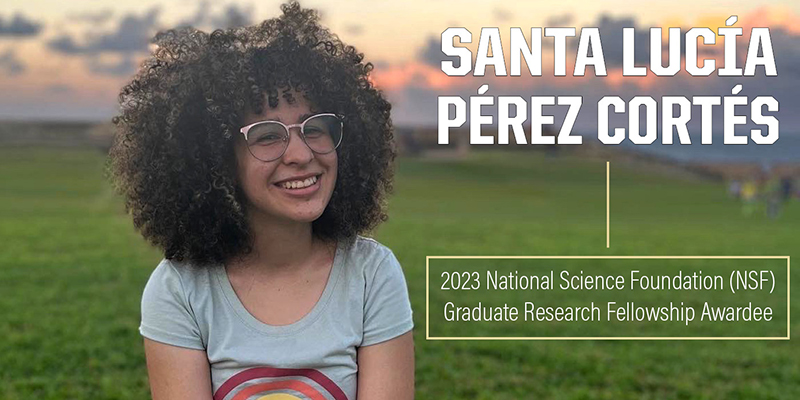Landslide research on distant planets earns Santa Lucía Pérez Cortés an NSF Graduate Research Fellowship
04-06-2023

Mapping, classifying, and taking measurements of landslides on the Moon and distant planets has earned Santa Lucía Pérez Cortés, PhD student with the Department of Earth, Atmospheric and Planetary Sciences (EAPS), a highly competitive National Science Foundation (NSF) Graduate Research Fellowship (GRFP).
Currently, she is using remote sensing data to identify and map landslides on the Moon in order to update existing landslide catalogs. In order to do this, she is classifying and taking measurements of all the landslides across the lunar surface. She uses datasets from instruments on the Lunar Reconnaissance Orbiter (LRO) to try to understand the terrain around these landslides. Instruments like Mini-RF are key to her research. She uses radar from the Mini-RF to look at patterns on the radar data that can indicate material properties at the landslide's locations, such as roughness. She says the main goal of this project is to understand the conditions that influence the formation of different mass wasting events in different geologic settings on the Moon and thanks to the NSF-GRFP, she will be able to expand this research to other planetary bodies.
According to the NSF, the program supports fellowships for outstanding graduate students who are pursuing full-time, research-based masters and doctoral degrees in science, technology, engineering or math or STEM education. The fellowship provides three years of support over a five-year fellowship period to help with the costs of education.
“Getting the NSF-GRFP means so much to me! When I saw the two institutions that formed me as a scientist listed along my name, it felt so special,” she says. “For me, it is very important to keep representing my alma mater, the University of Puerto Rico-Mayaguez and now representing my new home, Purdue University. I'm very happy to carry the name of these two institutions along with my name on this award. As a first-generation graduate student, as a woman, Latinx and a student educated in the Public School System in Puerto Rico, getting the NSF it's an opportunity to represent all the people that share all my identities and background.”
The highly competitive GRFP has a stringent application process. According to Pérez Cortés, the NSF-GRFP requests a personal statement, a research statement, three letters of recommendation, transcripts and supplemental materials that can show the work that the applicant has done during its undergraduate years.
“Something very specific about the NSF-GRFP is that on the personal statement you should include two sections called: Intellectual Merit and Broader impacts,” she explains. “I think that's the most important part of the personal statement. It's an opportunity to describe how you want to impact other with your education and how NSF plays a role on helping you archive those goals. My Intellectual Merit and Broader impacts are very related to increasing the participation of Latinxs in STEM, especially by making connection to my home, Puerto Rico.”
Pérez Cortés received her BS in Geology in June 2022. During her undergraduate studies, she worked on research related to eolian geomorphology looking at scouring pits in the Medusae Fossae Formation and depressions across North Polar dunes on Mars. Currently, Pérez Cortés is advised by Dr. Ali Bramson, Assistant Professor of Purdue EAPS.
“I definitely wouldn't have been able to do this without the help of my advisor, Dr. Bramson, who provided feedback on all materials and supported me during the application process,” says Pérez Cortés. “Also, my recommenders believed in me more than I believe in myself, and I will be forever grateful for that.”
Future graduate students who might be interested in obtaining an NSF GRFP can learn about the application process here.
About the Department of Earth, Atmospheric, and Planetary Sciences at Purdue University
The Department of Earth, Atmospheric, and Planetary Sciences (EAPS) combines four of Purdue’s most interdisciplinary programs: Geology & Geophysics, Environmental Sciences, Atmospheric Sciences, and Planetary Sciences. EAPS conducts world-class research, educates undergraduate and graduate students, and provides our college, university, state and country with the information necessary to understand the world and universe around us. Our research is globally recognized, our students are highly valued by graduate schools, employers, and our alumni continue to make significant contributions in academia, industry, and federal and state government.
Writer: Cheryl Pierce, Communications Specialist
Photo provided by Santa Lucía Pérez Cortés